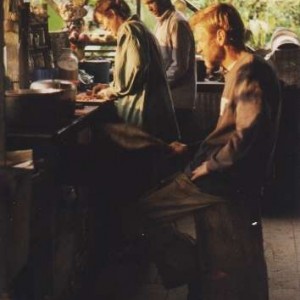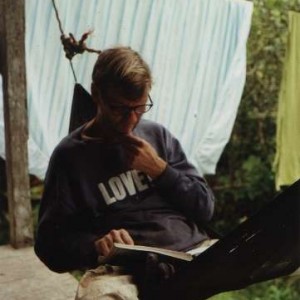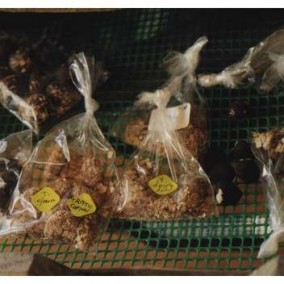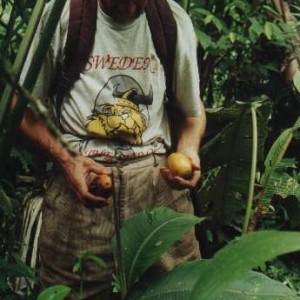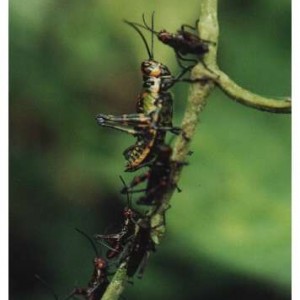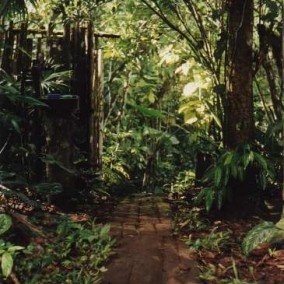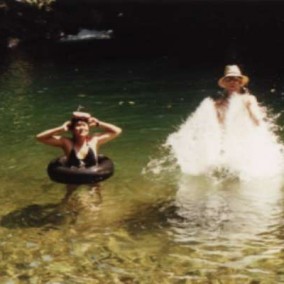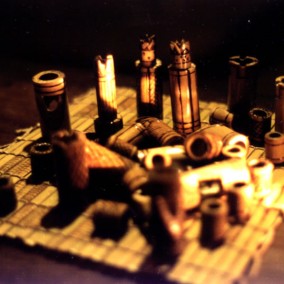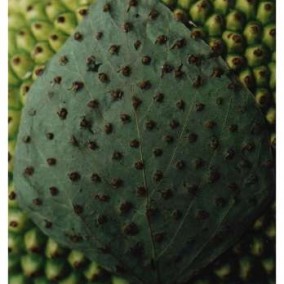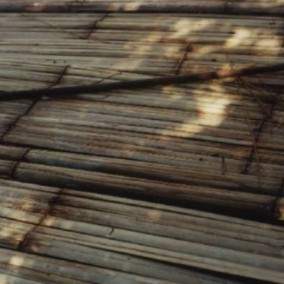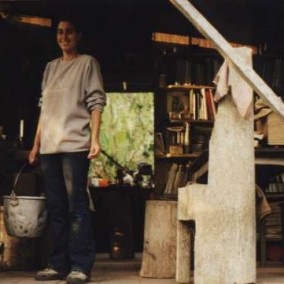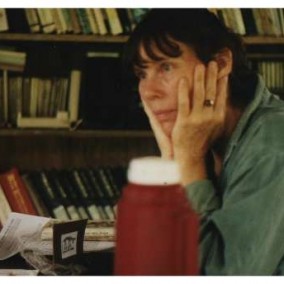Blog
the way
Rio Guaycuyacu – a day at the reserve
2000
Life begins at the main house about 7am when Jim and Meredith wake up and start to prepare a hot breakfast.
At about 7.30 I stir under the mosquito net gazing bleary eyed outside the mesh window into the forest canopy, then promptly fall asleep again. At around 8am the sound of a spoon hitting a metal pan lid, or a loud yodeling belly dancing yell comes sailing through the lemon tree in my direction and I crawl out of bed (a mattress layed on the woven rush mats covering the floor) and go down the wooden steps into the walk-in closet (a spare room with a bamboo bunk bed and some shelves) and change into some reasonably clean and comfortable clothes then make my way to the main house a hundred metres or so away to where breakfast is ready.
Breakfast is different every day. There is a ‘Colada’ – a porridge made from barley and oats onto which you can put granola, banana, milk and ‘miel’ which is not honey as the name suggests but liquid molasses ‘panela’ diluted to the consistency of syrup. Then there is a breakfast of fried eggs and ‘maduros’ – fried savory plantains with pan toast cut from fresh homebaked bread from the woodburning oven and stove they use for cooking everything. Banana pancakes with Araza jam and butter another day, and then omelette and yuca cake -grated manioc/cassava mixed with onion and red pepper and fried like a spanish omelette without the eggs for yet another day. That’s just breakfast.
After breakfast there is general activity around the kitchen when the two dogs, the cat and the seven chickens and three chicks get fed, some cacao beans get roasted and the beans or chickpeas or whatever else that needs long slow cooking will be put on the stove to catch the rest of its heat.
It’s around 8.30 now and I change into work clothes. Jeans or trousers heavily stained with banana sap, mud and grass. A shirt equally suffering and a pair of rubber boots and cap, gloves and machete in hand.
Jim leads the way through the plataneras, banana fields, through the cacao trees and into the fruit orchards.
More like thick jungle that orderly arrangement of trees, Jim has it all covered – literally, with kudzu. This is a leguminous vine which spreads over all the ground ensuring that the much needed nitrogen is fixed in the soil and keeps it fertile.
I feel like an intrepid explorer bushwhacking my way through the kudzu and nettles, over fallen trees, and crunching though gigantic, crisp palm fronds that have only started turning back into mulch. Crickets jump out from under my feet and butterflies flitter here and there among flowers.
Arranged in rows (although you wouldn’t know it) Jim has planted tropical fruit trees, his pride and joy. He has collected seeds from all over the world and now has over three hundred different species of tree. Every year (since 1986) different trees are only just beginning to bear fruit and many still have not yielded. He walks along spouting out botanical names of trees and plants and occasionally slashes a tree trunk so that we can see or taste the sap that comes oozing out. Caucho, latex, dragons blood, a medicinal sap. He’s clearly involved in a very deep relationship with his trees.
Jim inspecting some vine fruits he has just picked. He stops somewhere and taking a long bamboo fruit picker climbs a breadfruit tree. The fruit weighing over 10 pounds comes crashing down to the ground, its sticky sap white and covering its horny skin. “we’ll have this for breakfast tommorow” exclaims Jim then asks ” who wants to go up next?”
We proceed to a group of jaboticaba trees, a fruit similar to a cherry in size and colour and native to tropical Brazil. We all pick some straight off the branches where they grow and squeeze the soft, sweet, and delicious fleshy pulp out from the the thicker shell and spit the seed into the metal bucket.
Laying down white sheets under the tree, one of us climbs up the small trunk and runs a hand over the branches dislodging the fruit which falls in a cascade all over the ground. After collecting all the jaboticabas, we make our way back to the house stopping on the way to collect the peach/mango like arazas for juice. There is still some machette work to be done in the plataneras, but we’ll save that for tomorrow.
Achote, the red seeds are used as paintIts midday now and Jims internal alarm clock has rung. It’s time for food. This is probably the most predictable meal of the day although the combinations of things to eat are quite big. There is always tempeh, a protein rich soya product made by fermenting the soya bean and then inoculating it with a special fungus culture which turns the beans into a kind of white furry mass. This is used as their meat substitute and is marinaded in soya sauce with garlic and other spices then fried until golden brown. There is ground sesame, dutch cheese brought from Quito, homebaked bread, carambola (star fruit) pickle, homemade peanut butter, bean sprouts, hot pepper sauce and sometime a salad made from palm heart.
Jim shouts “Meeerreediith” up the stairs to summon her to lunch. She meanwhile has been busy writing her book, about among other things her experience of finding here natural parents after her adoptive mother died some years ago. She’s been working on it for two years now, and is a few days away from finishing the first draft. The next step for her is to find a publisher that is interested in her story.
We each take our blue rimmed white tin plates now filled with our selections over to the four hammocks and table in the living room. As we swing gently in the hammocks, dogs looking longingly at the plates, their heads swaying as their gaze follows, we look outside the house (there are no walls or windows downstairs) and watch the majestic rooster and the clucking hens run around amongst the flowers and small papaya tree planted just in front of the living room. Hummingbirds occasionally jet through on their way to the many flowers which surround us. The clouds are lowering over the tall rainforest trees on the hills in the distance and it begins to drizzle.
Jim slowly removes himself from his hammock which hangs just over the edge of the house and walks over to the bookshelf on which, amongst hundreds of botanical, environmental and otherwise fascinating books, are nestled a collection of World Book Encyclopaedias. He takes a handful and returns to his hammock where he proceeds to reel out information about things which have come up in conversation or which he has pondered about during the morning. The house is surrounded with book shelves, all neatly arranged by category and size. Soon we have all grabbed ourselves a handful of books or magazines – they have the whole collection of Whole Earth Review, and both Spanish and English editions of National Geographic.
By 1.30pm Jim and Meredith have gone upstairs for their siesta. The sun has come out now and we quickly make the most of it by grabbing our swim stuff and making our way down the steep steps past the horse Epona in her pasture to where the Guaycuyacu river falls from a cascade into a magnificent swimming hole.
Surrounded on all sides by virgin rainforest, the crystal clear water glistens with the sun filtering in rays through the trees. We run into the blue green water and swim up to the powerful bubbling cascade where we compete with one another to see who can get the furthest up into it before being expelled in a rush of white bubbles back into the main pool. With goggles on we can see the small fish swimming near the cascade and we jump and laugh like small children. The rock pools around the swimming hole and those further down into the river are teeming with life. Hundreds of tiny frogs -summer frogs Jim calls them, about the size of a shirt button bask in the sun, fly larvae hatch and jump from the edges and under the rocks and the occasional lizard can be seen. Butterflies dance all around us as we carefully step from rock to stone to sand bank as we zigzag our way to the river. Above us, the forest rises high on both sides.
By 3pm we have returned and are ready again for some other jobs. There are always lots of things to do, and Jim has many repair or construction projects on the go. He’s making bamboo whisks and fixing one of the drying racks used for storing seeds and other things and for drying cacao in the sun. Under the house are planks of wood all fashioned with a chainsaw and stacked. They are largely left over from when they built the house. The house structure, floorboards, sink, workbenches and stairs are made from a reddish coloured hardwood called Motilon. Many other parts such as the bookshelves are made from a softer white wood called Sande. Pambil which is the wood of an incredibly tall palm, has a rock hard outer wood which is black and dark brown in colour, similar to bamboo in structure and contains a pulpy soft core which can be scooped out or dried and carved.
We make some esterilla – a board made from bamboo that has been split many times along its length until it is flat. This is hard work with an axe, but rewarding-unless you get the axe in your knee as I did, then the dragons blood sap comes in handy.
Around one side of the house is Jims work bench and tools. He has every tool neatly arranged on a board with outlines and nailed in place. Standing near seems to attract all kinds of bugs to you. The main pest is a tiny, hardly-visible-at-all fly which is aptly called the Noseeum. It produces a bite similar to that of a mosquito and it itches like hell. You can’t see or hear it coming which is the main problem.
Sometime in the afternoon one of the women from Santa Rosa- a nearby village and two hours by foot or horse arrives with her twelve year old daughter. They bring milk, tagua seeds (vegetable ivory), and the result of an enterprise that Meredith is running with women from her village and Guayabillas, the other nearest village in the other direction. They have been shown how to make hair clip coverings and bracelets using small beads. We notice that both mother and daughter have dark round scars the size of plums on their foreheads and and cheeks. We find out that these are not burns as we first thought but leishmania scars, caused by a parasite which is transmitted by a sandfly. It creates an open wound which if left without treatment can grow very large before eventually healing over. It seems that this is a very common occurrence and everybody that lives here is affected at some time or other.
4.30 pm and Jim cracks open some fruits from which he needs to extract the seeds. He hands them to us to try, but mainly to make the task of seed extraction easier. We take the small yellow fruits and suck on the white pulp around the small seeds. This can be a tiring job, similar to stamp licking in that soon your tongue gets pretty tired of trying to pull the sticky pulp away from the seed.
He takes the seeds then and arranges them to dry on the floor under his seed bench where he sorts, counts and bags up the seeds he will sell, give away or exchange for other seeds he doesn’t have. Seeds come in all kinds of strange colours shapes and sizes. Smooth, striated, whispy, spiky or horny, bumpy, the variety is staggering.
By 5pm the kitchen starts coming to life again and there are lots of things to be done. Someone chops firewood whilst someone else makes araza juice. After the fruits have been squeezed between the fingers and put through a strainer, some panela miel is added for sweetness and for whoever wants it some ‘trago’ the local licor- something like vodka in taste. Someone else will do some grinding – peanuts, sesame, corn or cacao and some onions and garlic will be chopped for the beans. Whilst all this is going on we take turns to have a shower.
The shower is something else again. Just three sides of a room with no ceiling and no door with a floor, all made from slats of pambil. The shower head hangs from a hose which is connected to the complex network of water pipes which spread all the way from a natural spring in the hills to the tap that runs continuously in the kitchen sink, via the shower, nursery, garden and handwashing sink near the cabana. When any one of these taps is open fully the water in the kitchen tap stops running. Showers don’t last long usually and the experience is unforgettable. Facing away from the house and the cabana, it’s just you and the rainforest. All around you are the fallen lilac and white flowers of the surrounding bushes and the singing of birds for company. You can even drink the water from the shower if you want. It’s pure mineral spring water.
Changing once again into clean, comfortable clothes, preparation of dinner is resumed. The sun is beginning to set now and Jim tunes the short wave radio into the BBC World Service to hear the latest news or an article about world jazz or something. He lights the stove and sits back on the balsa wood trunk he and cat Mourka share as a stool, stokes the fire and looks onto a red sun sinking below the silhouetted distant forest tree line. Heating up the beans and frying the onion and garlic, the rice is set to cook and we busy ourselves by laughing at the antics of the dogs whilst the cat tries to jump on our laps now that she has been so rudely displaced by Jim. Meredith makes some hot sauce and tells us stories of how she and Jim met in the Peace Corps and Jim tells of how he avoided going to Vietnam.
The sky is a dark blue now and the electric light comes on in the kitchen attracting the thousands of moths, bugs and beetles mesmerised by its glow. Keeping the mosquitoes away from us now becomes almost a dance of waving arms. A beetle lands on the small table in front of us and we all peer at it whilst the sounds of insects serenading each other and of birds settling in for the night surrounds us noisily on all sides. Ants and small moths are difficult to stop from getting into food, the butter, jam or anything else slightly sticky for that matter. By the time we have all finished our supper we have each fished out numerous insects from our dishes.
It’s around 7pm by now and we settle back in the hammocks and listen to Meredith and Jim singing and playing the guitar accompanied naturally by the entire forest. By 7.30 they have both retired upstairs to read or answer the tens of emails they have stored on disk once a month from Quito and brought back to the farm to answer fully. They use a Macintosh Centris 610 (I’m using it now) for all their work and it makes communication a little speedier. The rest of us (three) remain in the living room, reading or playing Othello, or chess using the new set we have fashioned out of bamboo in our spare time. Grasshoppers six inches long occasionally fly by, soon to be massacred by Nissan the black dog, viewed with interest by Scruffy the small black puppy from his comfy bed of hessian rice sacs.
By 8.30 we too retire to the cabana to read and go to sleep. After checking to see if the clothes we have washed the day before have dried, in this humid place we take up our toothbrushes and brush our teeth in the wooden sink behind the cabana. We shine a flashlight onto a leaf hanging near the sink and say hello to the strange, brown, long legged spider which is always there on the same leaf during the night, but which seems to disappear in the day.
I take the flashlight then and make my way down the path through the forest to the toilet. This is a compost toilet which is nothing more than a hollowed out pambil base placed over a hole in the ground. A toilet seat has been shaped out of motilon and this hangs on a special hook on one of the three walls which make up the toilet room. You have to lift the lid off the toilet, place the seat on and then replace the lid before leaving. There is a ceiling which keeps the toilet paper dry which also goes straight down the hole to decompose. When one hole fills up, they simply dig another one and move the toilet house.
Back at the cabana I settle into our beds once more, tuck the mosquito net around me and read for a while. There is so much to read here that we sometimes have three or four books and magazines on the go at once. Outside, the moonlight illuminates the forest around me and sometimes I can see a kinkajou scampering between one branch and another.
By 9.30pm I turn out the light. It’s difficult to sleep. For one there is the stillness of the air. It’s heavy and moist. Then there is the cacophony of the insects dancing and singing to their drunken samba beat with maracas and whistles. Then there is the itching which seems to come from any part of your body that you happen to touch. Scratching alleviates for a few seconds, but these insect bites continue to itch. After some ten minutes of scratching you are sore. Maybe if we are lucky we will sleep. For me though it is not these things that keep me awake in the end. It is the ideas and images that swim around my head, making me imagine futures living in the rainforest canopy in treehouses, and of all the things I can make from Bamboo and vines. Eventually even I fall asleep.
For more information about Reserva Rio Guacuyacu:
